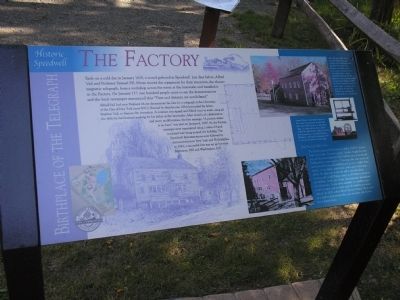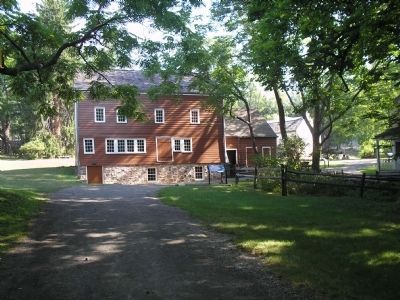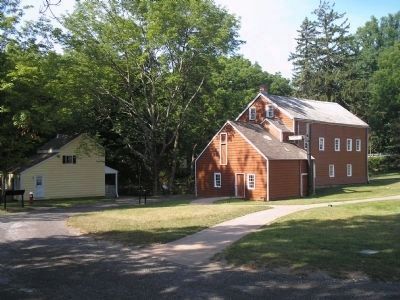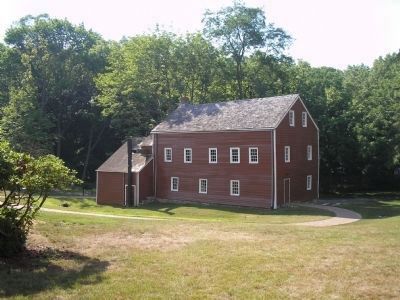Morristown in Morris County, New Jersey — The American Northeast (Mid-Atlantic)
The Factory
Birthplace of the Telegraph
— Historic Speedwell —
Early on a cold day in January 1838, a crowd gathered at Speedwell. Just days before, Alfred Vail and Professor Samuel F.B. Morse moved the equipment for their invention, the electromagnetic telegraph, from a workshop across the street at the Ironworks and installed it in the Factory. On January 11th, one hundred people came to see the demonstrations and the local newspaper announced that “Time and distance are annihilated.”
Alfred Vail had seen Professor Morse demonstrate his idea for a telegraph at the University of the City of New York (now NYU). Excited by what he saw, Alfred persuaded his father, Stephen Vail, to finance the invention. A contract was signed and Alfred went to work, using all the skills he had learned working for his father at the Ironworks. After months of collaboration and many modifications, the first message, “A patient waiter is no loser,” was sent on January 6, 1838. At the Factory, messages were transmitted using 2 miles of hand insulated wire hung around the building. The Speedwell demonstrations were followed by demonstrations in New York and Philadelphia. In 1844, a successful line was set up between Baltimore, MD and Washington, D.C.
After the successful demonstrations of the telegraph, Stephen Vail continued to use the Factory as part of his business operations. Later generations remembered the important events and preserved the building. By the time the property was set aside as Speedwell Village in 1968, the Factory had deteriorated and a major reconstruction was undertaken. In 1975 the building was designated a National Historic Landmark.
Samuel Morse’s invention started as the crude arrangement of wood and wire seen in the picture on the upper right. A replica of the device finely crafted by Alfred Vail, used to send the first long distance message between Baltimore, MD and Washington D.C. is seen in the picture to the right.
The Factory Building
The Factory was probably built as a mill in 1829 by Stephen Vail’s son-in-law, Dayton Canfield. Stephen bought the property and the water rights for $600 with the idea of turning the building into a cotton factory. To increase the water power, he had his workers move the building and set it on a higher foundation. A new flume, waterwheel, and a gear system were added. His plan was to rent the mill to investors from Paterson who would bring as many as 20 looms to set up in the building. At the last minute, the prospective manufacturers backed out. Despite many attempts, no sizable tenant could be found, and for many years the building was underutilized. In 1837, when Alfred Vail and Samuel Morse needed a room to demonstrate their new invention, the Factory was the logical choice.
Topics. This historical marker is listed in these topic lists: Industry & Commerce • Notable Buildings • Notable Events. A significant historical month for this entry is January 1838.
Location. 40° 48.844′ N, 74° 28.835′ W. Marker is in Morristown, New Jersey, in Morris County. Marker can be reached from Speedwell Avenue (U.S. 202) north of Cory Road, on the right when traveling north. Marker is located at Historic Speedwell. Touch for map. Marker is at or near this postal address: 333 Speedwell Avenue, Morristown NJ 07960, United States of America. Touch for directions.
Other nearby markers. At least 12 other markers are within walking distance of this marker. Ford Cottage (within shouting distance of this marker); Wheel House (within shouting distance of this marker); Worker Housing (within shouting distance of this marker); The Homestead Farm (within shouting distance of this marker); The Granary (within shouting distance of this marker); Vail House (within shouting distance of this marker); L’Hommedieu House (within shouting distance of this marker); 1849 Carriage House (within shouting distance of this marker); Homestead Carriage House (within shouting distance of this
marker); Vail Homestead Farm (within shouting distance of this marker); Moses Estey House (within shouting distance of this marker); Water Power at Speedwell (about 300 feet away, measured in a direct line). Touch for a list and map of all markers in Morristown.
More about this marker. The marker features a drawing of the Factory, a floor plan of the building and a picture of the telegraph being used. The sidebar includes modern photographs of the Factory, an early telegraph prototype and the completed telegraph device which sent the first long distance message. A map of Historic Speedwell also appears on the marker - see Other Nearby Markers.
Related marker. Click here for another marker that is related to this marker. - The first long-distance telegram.
Also see . . . Historic Speedwell - "Birthplace of the Telegraph". Morris County Park Commission website. (Submitted on July 11, 2010, by Bill Coughlin of Woodland Park, New Jersey.)
Credits. This page was last revised on April 22, 2024. It was originally submitted on July 11, 2010. This page has been viewed 1,110 times since then and 423 times this year. Photos: 1, 2, 3, 4. submitted on July 11, 2010, by Bill Coughlin of Woodland Park, New Jersey.



